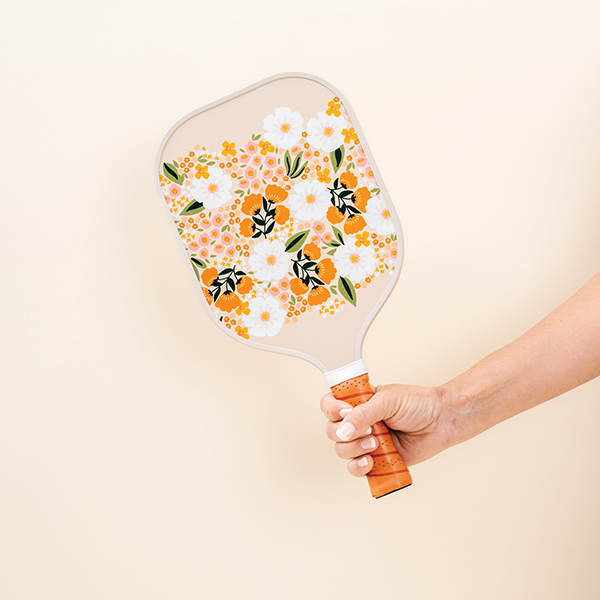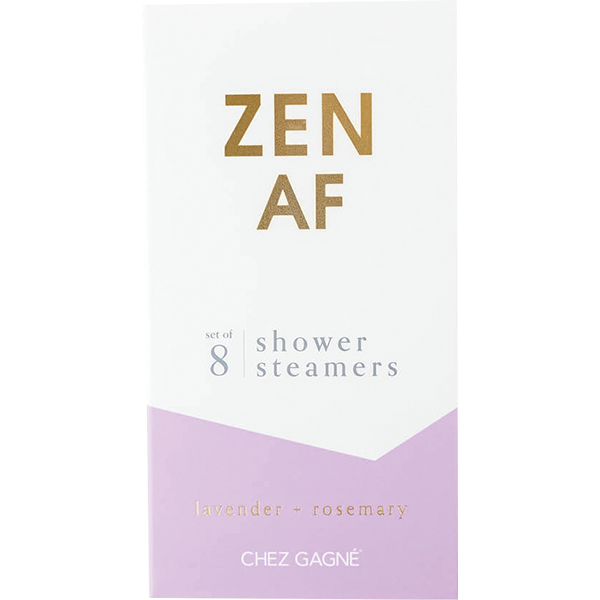Haute Holiday Decor
Be Fashion-Forward
Though traditional colors and themes still dominate home holiday décor, alternative materials, retro sensibilities and funky palettes are gaining ground. Today’s consumers are breaking away from the generic holiday colors and designs of yesteryear, according to Carla Meehan, marketing director of wholesale distributor burton + Burton, of Bogart, GA. The company carries multiple lines of fanciful, fashion-forward Christmas décor. “The trends we’re seeing right now aren’t as rigid as they have been in the past. Because people are so busy, they are using holiday décor as a means to enhance their stay-at-home lifestyles,” Meehan says.
Santas, reindeers, snowflakes and—to a lesser extent—Hanukkah menorahs and Kwanzaa kinaras are still best buys, but consumers are looking for trendy new twists on the old standards.
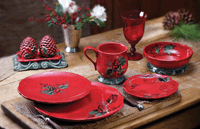 The market for home holiday décor—which has remained steady at roughly $8 billion for the past two years, according to a report released in 2005 by market research firm Unity Marketing—has customarily evolved slowly, changing primarily in response to shifts in the entire home décor market. Now, as the pace of life grows ever faster, what’s hot for the holidays can change dramatically year by year.
The market for home holiday décor—which has remained steady at roughly $8 billion for the past two years, according to a report released in 2005 by market research firm Unity Marketing—has customarily evolved slowly, changing primarily in response to shifts in the entire home décor market. Now, as the pace of life grows ever faster, what’s hot for the holidays can change dramatically year by year.
“Holiday décor is becoming much more accessible, and this has affected the speed at which the market is changing. Consumers are choosing décor options that are more elaborate and aseasonal, and manufacturers are responding to this demand. Together they’re dumping fuel on the industry fire,” says Scott Krugman, vice president of industry public relations for the National Retail Federation, the world’s largest retail trade association.
“It’s trending up. On average, consumers spent $40.86 during the 2005 holiday season, compared to $35.91 in 2004 and $34.18 in 2003. But it’s impossible to predict what’s going to happen in that fourth quarter, because there are so many economic variables that might come into play.”
Holiday décor is no longer something unceremoniously dredged out of the basement once a year and hastily re-stowed once the season has passed. People are decorating for the holidays earlier and leaving their décor up longer, according to Krugman. As a result, consumers are looking for holiday décor that blends in with their existing items. Product development teams throughout the industry are looking for inspiration toward textiles, furniture and even appliances.
“It’s not about putting a pretty piece on the table anymore. People are taking the holiday pieces they buy and using them to tell the story of their lives,” says Dallas Market Center design expert and American Floral Industry Association spokesman J M.H. Schwanke. “Retailers as well as wholesalers have to be attuned to that.”
Retailers like Sonja Simmons, founder and owner of Reflections On Main, a gift shop in Albemarle, NC, whose offerings include mouth-blown, hand-painted glass holiday ornaments, has watched her customers embrace décor that is representative of their interests, their personalities and their values. “People want stylized items that say something about who they are,” she explains.
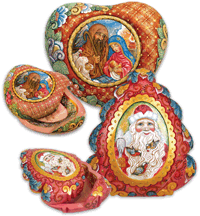 Holiday décor that is as expressive as it is individual, and imbued with character, is captivating consumers and inspiring them to invest more thought—and more money—in their Christmas, Hanukkah and Kwanzaa adornments.
Holiday décor that is as expressive as it is individual, and imbued with character, is captivating consumers and inspiring them to invest more thought—and more money—in their Christmas, Hanukkah and Kwanzaa adornments.
A more colorful Christmas
Christmas is still very much a holiday in which tradition reigns, according to Craig Schultz, owner of Group One Associates, a wholesale distributor of hundreds of styles of glass Christmas ornaments. “That doesn’t mean there isn’t room to funk it up a little,” Schultz says.
Red, green, white, silver and gold are still the mainstays of the business, “but that isn’t to say you can’t couple them with a vibrant or unusual accent color,” he says. “We put a splashy, colorful twist on a range of our products each year, and they continue to sell wonderfully.”
According to Schwanke, many consumers are avoiding old-fashioned hues like kelly green and gravitating toward fresher kiwi, grass and olive tones in everything from tableware and candles to stockings, to ornaments and figurines. Lighter, more whimsical colors, including pastel pinks and soft oranges, are gaining in popularity. Stark blacks and reds, often presented with Eastern flair, have found a foothold among the buying public.
Schwanke adds that the strong, earthy tones that caused a stir on the 2005 fashion runways are showing up in holiday décor. “Rich chocolate brown is as hot as it is unexpected. I saw it emerge last year, and it’s getting bigger and bigger. Chocolate is being successfully paired with pinks and blues, like aqua. It’s an anchor color that’s only going to get stronger,” Schwanke says.
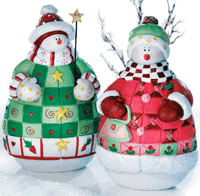 Some retailers are nonetheless anticipating a resurgence in the popularity of traditional colors paired with traditional themes. Carol McBride, sales manager of The Christmas Shoppe in Boerne, TX, believes that while modern and retro pieces continue to sell well, people are gradually changing gears and looking backward for inspiration when choosing their Christmas décor. She predicts that there will be a resurgence in the popularity of deep reds and bright whites.
Some retailers are nonetheless anticipating a resurgence in the popularity of traditional colors paired with traditional themes. Carol McBride, sales manager of The Christmas Shoppe in Boerne, TX, believes that while modern and retro pieces continue to sell well, people are gradually changing gears and looking backward for inspiration when choosing their Christmas décor. She predicts that there will be a resurgence in the popularity of deep reds and bright whites.
“I think people got very caught up in the themed trees and the really intensely modern looks,” she says. “Today they’re saying, ‘That was fun for one or two years, but now I’d like to buy Christmas décor that looks like Christmas décor.'”
Christmases past
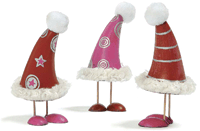 Whereas many wholesale distributors and retailers, as well as consumers, are looking to the past for Christmastime insights, a select few of the former have honed in on nostalgia as a marketing tactic. And it’s paying off. The robin’s egg blues and pale pea soup greens that were the definition of chic in the kitchens of the 1950s and ’60s are showing up in functional and decorative tabletop Christmas décor.
Whereas many wholesale distributors and retailers, as well as consumers, are looking to the past for Christmastime insights, a select few of the former have honed in on nostalgia as a marketing tactic. And it’s paying off. The robin’s egg blues and pale pea soup greens that were the definition of chic in the kitchens of the 1950s and ’60s are showing up in functional and decorative tabletop Christmas décor.
Themes are at least as important as price point, according to Grace Peña, marketing product manager of wholesale distributor Fitz and Floyd Inc., which has developed Mingle Jingle Be Merry, a line of retro-styled Christmas figurines and housewares. “The vintage look is very in,” she says. “We’re trying to appeal to younger consumers, and they seem to be quite taken with the styles and colors popular 40 and 50 years ago.”
This love affair with the past isn’t limited to younger consumers. “The baby boomers are very nostalgic, but they want the looks they so fondly remember updated and brought into the present,” says Schwanke. “Everyone wants to relive the fun of childhood—to recapture the enthusiasm they had for Christmas as kids. It really drives the consumer.”
This desire to recapture the essence of the past tends to attract consumers to decorations resembling those they remember from childhood, and to timeless heirloom pieces that will retain their beauty over time. “People want to stay true to their history while creating a new family history. Because of this, glass will always be popular,” says Heinz-Guenther Reichert, president of Reichert & Baden, of New York, which features classically styled European Christmas ornaments. “If people recall their grandmother’s glass ornaments joyfully, they will try to replicate that look,” Reichert says.
Advertising the miracle
Tradition still thrives in the Hanukkah décor market, though people’s desire to express their beliefs has expanded the selection of Hanukkah merchandise available to consumers. Whereas in the past, a Jewish home might have gone unadorned leading up to Hanukkah, Susannah Ruditsky, owner of Jobiru Judaica Imports, sees increasing numbers of Jewish people expressing their faith through cheerful and fun holiday décor. Ruditsky is a wholesale distributor in White Plains, NY, who specializes in Jewish gifts and imports.
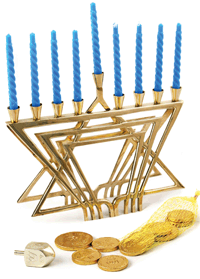 Hanukkah décor, like Christmas décor, represents a variety of tastes, ranging from the traditional to the contemporary. “The market has diversified to reflect a wider range of personal styles. Christmas has always been very festive and very public, while Hanukkah has been more of a private celebration. That’s changing. People are putting up strings of blue and white lights outdoors and decorating their windows with Stars of David,” Ruditsky says.
Hanukkah décor, like Christmas décor, represents a variety of tastes, ranging from the traditional to the contemporary. “The market has diversified to reflect a wider range of personal styles. Christmas has always been very festive and very public, while Hanukkah has been more of a private celebration. That’s changing. People are putting up strings of blue and white lights outdoors and decorating their windows with Stars of David,” Ruditsky says.
The enthusiasm for decorative items commemorating the Festival of Lights has resulted in a market for plush dreidels; Stars of David in blue and white lights; high-end menorahs in silver, glass, and ceramic; and more.
The market for both indoor and outdoor decorations is growing quickly, and sales of all-weather decorative Hanukkah lights are doubling year by year, according to Ben Zabablotsky, owner of ZionJudaica in Brooklyn, NY, a retail and wholesale distributor of Jewish art, jewelry and décor. “We never know how much merchandise to buy, and many of the items we stock sell out quickly. Consumers are ready to spend more money on larger items, so we’ve expanded our focus to include lawn decorations such as inflatable menorahs.”
A celebration of heritage
Kwanzaa—a holiday that focuses on the traditional African values of community responsibility, family, commerce, and self-improvement—represents a conundrum for décor wholesale distributors, retailers and consumers alike. Because the focal point of the holiday is the celebration of African traditions, individuals observing Kwanzaa tend to adorn their homes not only with holiday-specific décor, but also with reproductions of African artifacts, traditional woven cloth, wooden figurines and artwork.
Retailers may have difficulty catering to consumer demand for holiday-specific merchandise because of the relative paucity of wholesale distributors offering more than one or two pieces of Kwanzaa décor. Consumers who are ready to expand their Kwanzaa collections are sometimes disappointed by their small range of choices.
“If the product is out there, people will buy it,” says Kathy Gaynor, owner of HBS Kwanzaa Shop, an online retail and wholesale outlet in the Bronx that carries a selection of Kwanzaa décor. “I think more people are celebrating Kwanzaa, as my sales have gone up year by year. But the selection of decorative items people can choose from has remained fairly limited.”
The centerpiece of the Kwanzaa celebration is the kinara, a candelabrum that holds seven candles representing the seven principles of the holiday. In the past, most kinaras were crafted of dark wood, but today there is a wide range of artful and sophisticated metal and glass kinaras that consumers can choose from. More people are also choosing to decorate their homes with the Kikombe cha umoja, a communal cup representing unity, and the Mkeka placemat. “People are buying more ornate and expensive pieces as they become available. There’s no limit to the ways one can decorate one’s home for Kwanzaa. It is one of the few holidays that encourages kuumba, or creativity,” Gaynor says.
Décor demographics
 She or—to a lesser extent—he who runs the household rules the roost when it comes to selecting and buying holiday décor. Women in their 30s and 40s constitute the heavy-hitting consumers of the industry, according to McBride, who has seen a growing number of people coming to The Christmas Shoppe with the intent of creating a more urbane Christmas décor scheme.
She or—to a lesser extent—he who runs the household rules the roost when it comes to selecting and buying holiday décor. Women in their 30s and 40s constitute the heavy-hitting consumers of the industry, according to McBride, who has seen a growing number of people coming to The Christmas Shoppe with the intent of creating a more urbane Christmas décor scheme.
She notes that women whose children have entered their teen years tend to buy more expensive holiday items. “When families are just starting out, the kids make the decorations or have a lot of influence in what is displayed. As a customer grows older, she wants a tree that’s reflective of her values and tastes. As a result, many people are putting up multiple trees. There might be smaller trees in the kids’ rooms and the den, decorated with family ornaments, and a larger, more ornate tree in the living room that is a showcase for expensive heirloom pieces and fancier ornaments.”
Displays that capture the eye and the heart
When consumers want to turn up the holiday cheer, fun, sassy and decorative items are frequently the pick-me-up that they turn to, according to Cindy Lowry, owner and president of Blossom Bucket in North Lawrence, OH, a wholesale distributor of holiday folk art and resin accessories. “Every year people buy a little piece or two to update or jazz up their holiday décor collection. It’s a great way to get into the spirit of the holidays. But because of that, ornaments and other holiday decorations are an impulse buy for a lot of people.”
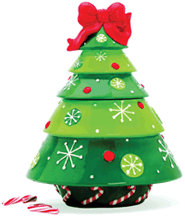 According to a report released in 2005 by the National Retail Federation, the average consumer was prepared to spend only $40.86 on holiday décor. The key to increasing that number, according to McBride, is creating lighthearted and aesthetically pleasing holiday displays that consumers can replicate in their own homes. At The Christmas Shoppe, themed Christmas trees dominate the floorscape. “We put up themed trees. The ornaments featured on a specific tree are displayed individually on pegs and baskets near that tree. People who shop in our store don’t just buy ornaments—they buy ideas. We’ve had customers ask to buy the already-decorated trees, and in that case, we’ve put together individual packages based on the specific design scheme.”
According to a report released in 2005 by the National Retail Federation, the average consumer was prepared to spend only $40.86 on holiday décor. The key to increasing that number, according to McBride, is creating lighthearted and aesthetically pleasing holiday displays that consumers can replicate in their own homes. At The Christmas Shoppe, themed Christmas trees dominate the floorscape. “We put up themed trees. The ornaments featured on a specific tree are displayed individually on pegs and baskets near that tree. People who shop in our store don’t just buy ornaments—they buy ideas. We’ve had customers ask to buy the already-decorated trees, and in that case, we’ve put together individual packages based on the specific design scheme.”
“Additionally, the Boerne community is very German, so we give away a free pickle ornament to customers who come in and browse the store. We advertise the free pickle in the tourist magazines and brochures. It really draws people in. Of course, we hide a pickle in each of our display trees,” she says.
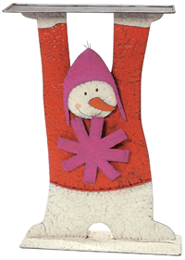 Evoking the spirit of the holidays can put consumers in a buying mood. Displays that feature a fully decorated Christmas tree, a menorah ready to be lit at the start of the holiday, or a Kwanzaa kinara on kente cloth serve a twofold purpose. They give stores a festive, jolly air in a very organic way. And, more important, they inspire an emotional response.
Evoking the spirit of the holidays can put consumers in a buying mood. Displays that feature a fully decorated Christmas tree, a menorah ready to be lit at the start of the holiday, or a Kwanzaa kinara on kente cloth serve a twofold purpose. They give stores a festive, jolly air in a very organic way. And, more important, they inspire an emotional response.
“Make consumers feel good and you make sales,” says Candace Wright, manager of The Cotton Gin, a décor and collectable retailer located in Jarvisburg, NC. “We want our customers to have a memorable experience when they browse the store. If we’re doing our jobs right, our displays will make people feel really happy and in synch with the holiday spirit.”
The human obsession with holidays is steeped in emotion. The Christmases, Hanukkahs and Kwanzaas that touch people deeply are the ones that remain forever ingrained upon their memories. And yet each new holiday season represents an opportunity to create new memories and new stories. Holiday décor that tells a story and tells it passionately will never fail to engage consumers and capture their hearts.



















